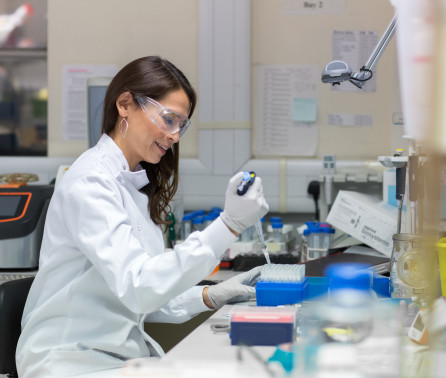1.Optimising antibiotic therapy in multimorbidity using intelligent, personalised clinical decision support systems
We have developed and CE marked a clinical decision support system which can utilise routinely collected data alongside machine learning algorithms to predict an individual’s risk of infection and which antimicrobial agent is most likely to successfully treat the infection.
This could be a valuable resource to aid decision making for clinicians who are not experts in infectious diseases when deciding whether to start antimicrobial therapy, and which antimicrobial to use.
2. Point of Care (PoC) and Microneedle Sensors for antimicrobials
We are developing a pipeline of biosensors for several antimicrobial drugs which can be functionalised onto our microneedle platform. This offers a minimally invasive and real time measurement of antimicrobial concentrations directly from the interstitial fluid. We have published our first-in-man, healthy volunteer proof-of-concept study of the microneedle device in Lancet Infectious Diseases.
A novel method for direct electrochemical detection of cefiderocol was published in Electrochemistry Communications and the sensor is currently undergoing clinical validation.
3. Continuous minimally-invasive sensing of lactate for individual risk-stratification and antimicrobial optimisation
Ten healthy participants were recruited to a first-in-man, healthy volunteer proof-of-concept study evaluating a newly designed lactate microneedle biosensor. Lactate results between the microneedle and conventional blood sampling showed good agreement. The device was well tolerated by participants. This low-cost platform offers a minimally invasive, real-time approach which might be used to aid in the detection and monitoring of septic patients.
4. Improving antimicrobial treatment of CNS infection through the development and validation of peripheral real-time monitoring and machine learning algorithms
We analysed data from nice individuals treated for nosocomial ventriculitis with vancomycin undergoing therapeutic drug monitoring (TDM) of cerebrospinal fluid (CSF) and blood. The aim was to evaluate the utility of CSF TDM. The study published in Journal of Infection highlights poor penetration of vancomycin into the CSF. Several challenges with CSF TDM are highlighted including assay limits of detection and differences between target site monitoring.
The CSF might prove to be a valuable sampling site for TDM and future work will explore other drugs and novel sensors to aid in real time drug monitoring.
5. Improving antifungal treatment and addressing antifungal resistance in cystic fibrosis-(CF) related fungal lung disease
The Omnilog system in place at CAMO has been optimised and validated for high-throughput phenotypic microarray analysis in fungi. Multiple clinical and environmental triazole sensitive and resistant isolates have been characterised across 4 different microarray plates (pH, osmotic stress, carbon source, nitrogen source). We have implemented a novel bioinformatic workflow to enable integration of large-scale phenotypic data with clinical, microbiological and genomic data.
6. The role of RNA Sepsis Response Signatures (SRS) in guiding Sepsis therapy
Preliminary work in the SRS project has shown a high rate of matching SRS classifications across the technologies used to assign SRS previously with this PCR platform on the QuantStudio 7 Flex when analysing the qPCR data obtained from the 7-gene set for SRS. Future work will focus on the assignment of SRS using qPCR as a point of care test. This can be coupled with existing published literature highlighting a differential response to corticosteroids in septic patients amongst the SRS sub-phenotypes, with the aim of personalising treatment and improving mortality in sepsis.
